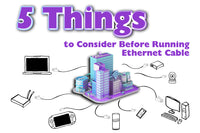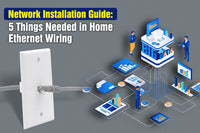Contents
A good network system not only requires a high-quality network cable but also good cable management. Many people may ignore the importance of cable organizers, but do you want to walk into your room finding that a lot of cables dangling from the server rack? Network cable spaghetti can be a disaster, so how to avoid this from happening? Look at our post.
Why is Cable Management Important?
Cable management is often overlooked in network installation. Do you want your cables tangled together? Do you want to see cable spaghetti in the data center or server room? If not, you need good rack cable management. A good cable management can not only give you a clean network environment but also offer many other benefits.

- Safety: Too many tangled cables can cause overheating and may result in a burst of fire. Proper organized cables reduce the risk of accidents. In addition, organized cables can also help avoid cable disconnection and data loss.
- Easy use: With rack cable management and cable labeling, it is easy to find the non-working cables and what devices are connected to the cables.
- Future-proofing maintenance: Well-organized cables are easy to identify so that they can be maintained quickly. Moreover, they also help easily upgrade your network facilitate in the future.
- Airflow: Properly network cable management allows for free airflow. Proper airflow can help increase efficiency energy and maintain a low temperature, which is beneficial to network cable speed and related equipment performance.
Cable Management Types
Horizontal Cable Management
Horizontal cable management is the most commonly used cable management method. The cables are often organized on the rack front, placed in one place, and separated by the cable manager. In general, the horizontal cable management is 1U or 2U high. There are many different horizontal cable managers such as managers with D-ring or brush strips. Horizontal cable management helps IT technicians to identify and trace the device quickly and easily.
Vertical Cable Management
Vertical cable management is a solution to organize, bundle, and fix cables in a vertical direction within the rack. Cables can be bundled up at the upside or downside. One advantage of vertical cable management is that it allows cables to bend at a proper angle that will not affect cable performance. And it can effectively reduce interference, allowing for high-quality signal transmission.
Tips for Network Cable Management
Here are our cable management tips for network installers, IT technicians, and novices:
- Plan properly before everything. Consider the number of cabling and connections and the place of installing cables and racks. Remember the saying in your mind, “Measure twice, cut once,” so you should carefully measure the cables and cut them at a proper length. In addition, everything needs to be prepared before adding other racks and network hardware.
- Don’t forget cable labeling. Cable labeling can be challenging when organizing network cables, but it will benefit you in the future. It would help if you labeled both ends of ethernet cables, patch panels, and other network components in the installation, making it easy for IT technicians and network installers to identify cables.
- Follow the industry standard. Network cable management is essential in data centers and server rooms, and you should follow industry standards for excellent network performance. For example, you should follow ANSI/TIA standards and other local regulations for the cabling system.
- Terminate with patience. Proper and accurate termination is very important for stable data transmission. If you need to terminate many cables, take time to do it; if the connection is lost, re-terminate them. The Ethernet patch cable is also a great option to simplify your termination.
- Avoid sharp bends. Many people may think Ethernet cables are robust and can be bent to different angles. But in fact, different Ethernet cable categories feature different bend radius, which is often included in the cable specification. Remember not to twist the cable to a very sharp bend, or you’ll get a poor signal or data loss.
- Choose the right cable management tool. Don’t choose too cheap Ethernet cables or cable managers as poor-quality cables and hardware may cause data loss. In addition, choose those cable managers that can ensure well cable and connection performance.
3 Must-have Accessories Used in Cable Management

Server Racks: Server cabinets or racks are one of the basic components in the cable management system. Server racks are available in open server racks, server rack cabinets, and wall-mount racks. Most data centers and server rooms use 19-in-wide server racks, but you can choose one based on your own needs. Look at the post server racks and cabinet to know more information.
Cable Ties&Cable Labels: Cable ties and cable labels are necessary accessories for cable management. Cable ties are divided into plastic and Velcro ties. Velcro ties are popular nowadays as they are reusable and easy to remove. Cable ties play an important role in bundling cables in the rack. Cable labels help quickly manage the cable.
Patch Panel: Patch panels are an inexpensive solution to cable clutter. They provide high-density cable management and lower maintenance cost. Patch panels are essential in a structured cabling system.
For more information on this topic, you can keep up on our blogs. While VCELINK offers general and basic information for our customers and other visitors to the website, it’s not professional advice.






Be the first one to comment.
Leave a comment